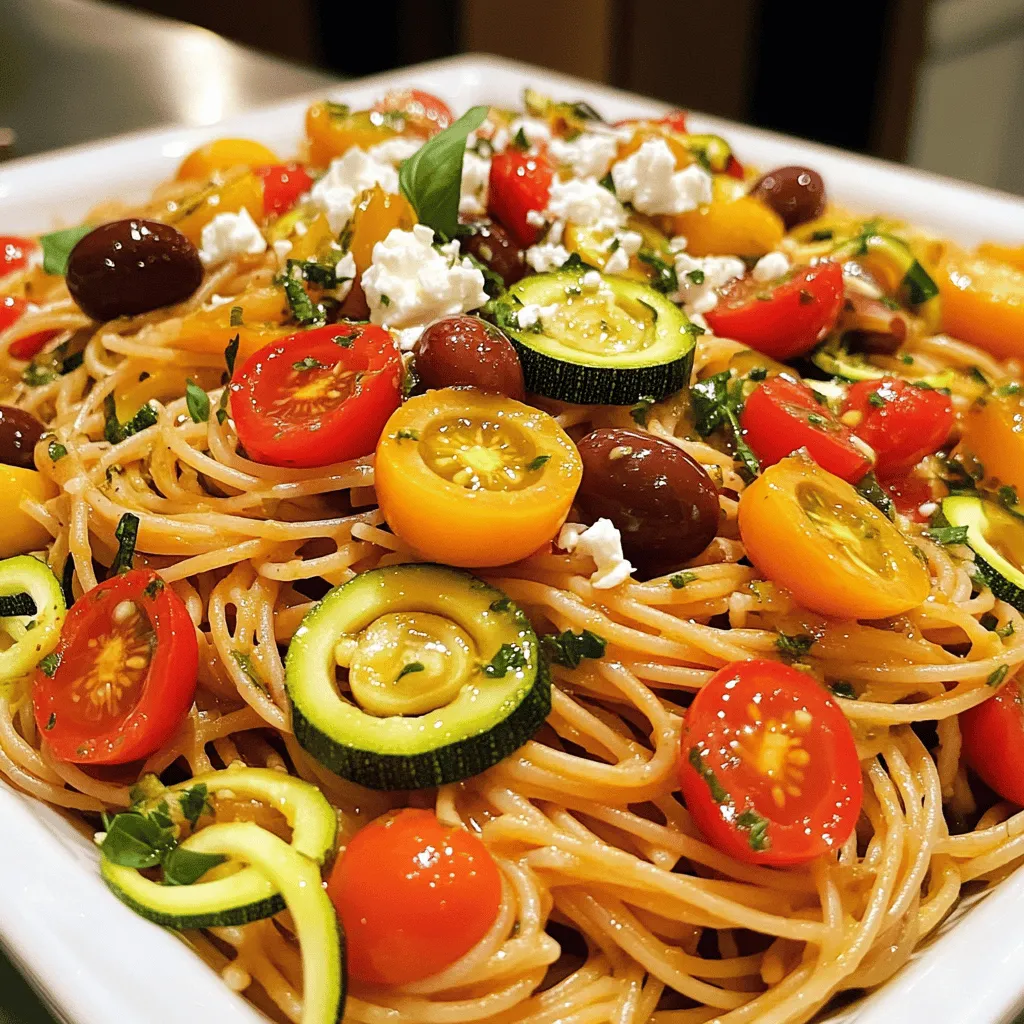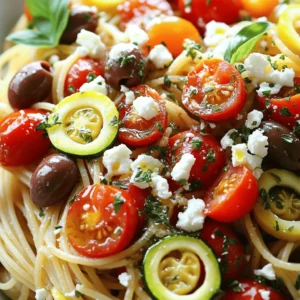If you crave a dish that bursts with flavor and is quick to make, then Mediterranean Pasta is your answer! This guide will walk you through simple steps to create a vibrant bowl of goodness using fresh veggies, whole wheat spaghetti, and rich flavors. Whether you’re cooking for yourself or impressing guests, this healthy recipe is both satisfying and easy. Get ready to explore the sunny tastes of the Mediterranean!
Ingredients
Primary Ingredients for Mediterranean Pasta
– 8 oz (225g) whole wheat spaghetti
– 1 cup cherry tomatoes, halved
– 1 cup Kalamata olives, pitted and sliced
– 1 cup feta cheese, crumbled
– 1 medium zucchini, spiralized or diced into small pieces
– 1 red bell pepper, diced
– 2 cloves garlic, minced
– 1/4 cup extra virgin olive oil
– 1 tablespoon fresh lemon juice
– 1 teaspoon dried oregano
– Salt and freshly cracked black pepper to taste
For this Mediterranean pasta dish, I love using whole wheat spaghetti. It adds a nutty flavor and more fiber. Cherry tomatoes bring sweetness and bright color. Zucchini gives a nice crunch, while red bell pepper adds a slight sweetness. Garlic enhances the taste, making the dish more flavorful. Extra virgin olive oil and lemon juice are key for a fresh finish. Dried oregano adds depth, and Kalamata olives bring a salty touch. Finally, feta cheese adds creaminess and a tangy kick.
Optional Garnishes
– Fresh basil leaves
– Additional feta cheese
– Cracked black pepper
Garnishes make the dish pop! Fresh basil leaves add a lovely aroma and freshness. Extra feta cheese can enhance the creaminess. A sprinkle of cracked black pepper gives a nice kick. These garnishes make your Mediterranean pasta even more appealing and tasty.
For the complete recipe, check out the Full Recipe.
Step-by-Step Instructions
Cooking the Pasta
Start by boiling water in a large pot. Make sure to add a good amount of salt; this helps flavor the pasta. Once the water boils, add 8 oz of whole wheat spaghetti. Cook it for about 8 to 10 minutes until it’s al dente. Al dente means the pasta is firm but not hard. Before you drain it, save 1/2 cup of the cooking water. Then, drain the spaghetti and set it aside.
Sautéing the Vegetables
In a large skillet, heat 1/4 cup of extra virgin olive oil over medium heat. Once the oil is hot, add 2 cloves of minced garlic and 1 diced red bell pepper. Sauté these for 2 to 3 minutes. You want the bell pepper to soften and the garlic to smell great. Stir often to keep the garlic from burning.
Mixing Ingredients
Next, add 1 cup of spiralized or diced zucchini and 1 cup of halved cherry tomatoes to the skillet. Cook this mix for another 4 to 5 minutes. The tomatoes should soften and release their juices, making a light sauce. After that, gently toss in the drained spaghetti along with the reserved pasta water. Use tongs to mix everything well.
Now it’s time to add the flavor! Fold in 1 cup of sliced Kalamata olives, 1 cup of crumbled feta cheese, and 1 tablespoon of fresh lemon juice. Sprinkle in 1 teaspoon of dried oregano, and season with salt and freshly cracked black pepper. Mix it all together to spread the flavors evenly.
For a full recipe, check out the complete guide!
Tips & Tricks
Perfecting the Pasta Texture
Salting the water properly is key. Use a good amount of salt, like the sea. This helps the pasta taste better. It also helps bring out the flavors of the dish. The water should taste a bit like the ocean.
Reserving pasta water is also important. Before you drain the pasta, save about half a cup. This starchy water helps blend your sauce. If your sauce is too thick, add a splash of this water. It brings everything together nicely.
Flavoring Techniques
Enhancing flavors with herbs and spices makes a big difference. Fresh herbs like basil and oregano add brightness. You can also use dried herbs if fresh are not available. Just remember, dried herbs are stronger, so use less.
Balancing acidity with lemon juice is essential. A squeeze of lemon brightens the dish. It cuts through the richness of the cheese and oil. Try adding a bit at a time until you find the right balance.
Presentation Tips
Serving suggestions for visual appeal matter. Use wide, shallow bowls to show off the colors. This allows the vibrant veggies to shine. Drizzle a bit of extra olive oil on top for shine.
Garnishing ideas for added flavor include fresh basil leaves. They not only look great but add a fresh taste. You can also sprinkle extra feta cheese for richness. A dash of cracked black pepper can elevate the dish too.
For the complete recipe, check out the Full Recipe.

Variations
Different Pasta Types
You can use many pasta types for your Mediterranean dish. Whole wheat spaghetti is great, but you can also try gluten-free pasta. Gluten-free options like brown rice or chickpea pasta work well too. They hold up nicely with the veggies and sauce.
Additional Ingredients
To make your pasta heartier, add proteins like chicken, shrimp, or chickpeas. Grilled chicken adds a nice flavor and pairs well with the dish. Shrimp cooks quickly and adds a fresh taste. Chickpeas are a great plant-based option. They add protein and texture. You can also toss in seasonal vegetables. Think of bell peppers in summer or roasted butternut squash in fall. They bring color and taste to your meal.
Flavor Profiles
Mediterranean cooking shines with spices and herbs. Use dried oregano, basil, or thyme for depth. You can also switch up the cheese. Feta gives a tangy taste, but try goat cheese or mozzarella for a creamier flavor. Each cheese brings its own unique charm to the dish.
For the full recipe, check out Mediterranean Sunset Pasta.
Storage Info
Proper Storage Techniques
To keep your Mediterranean Sunset Pasta fresh, store it right. First, let the pasta cool down. Then, place it in an airtight container. This step helps keep the pasta moist. You can refrigerate it for up to three days. If you want to save space, divide the pasta into smaller portions. This makes it easier to grab a meal later.
Reheating Guidelines
When it’s time to enjoy your leftovers, reheat carefully. The best way is to use a skillet. Add a splash of water or olive oil to the pan. Heat it on medium-low. Stir often to keep it from drying out. You can also use the microwave. Cover the dish with a damp paper towel. This helps trap steam and keeps the pasta soft.
For a fun twist, try serving it cold as a pasta salad. Add extra fresh basil and a drizzle of olive oil. This way, you can enjoy Mediterranean flavors in a different way!
FAQs
How long does Mediterranean Pasta last in the fridge?
Mediterranean Pasta lasts about 3 to 4 days in the fridge. Store it in a sealed container. Look for signs of spoilage like off smells or mold. If the pasta looks dry or clumpy, it might not taste good anymore. Always check before you eat.
Can I make Mediterranean Pasta ahead of time?
Yes, you can make Mediterranean Pasta ahead of time. It’s great for meal prep. Just cook it, let it cool, and store it in the fridge. You can make it up to two days in advance. To reheat, add a splash of water or oil to keep it moist.
What are some side dishes to serve with Mediterranean Pasta?
Serving Mediterranean Pasta with side dishes can enhance your meal. Here are some ideas:
– A fresh Greek salad with cucumbers, olives, and feta.
– Garlic bread or a crusty baguette to soak up the sauce.
– Roasted vegetables for more flavor and nutrients.
– A light soup, like minestrone, for a warm starter.
Feel free to mix and match these sides to create a balanced meal! For the full recipe, check out the Mediterranean Sunset Pasta.
Mediterranean pasta is a simple and tasty dish. We covered its key ingredients, from whole wheat spaghetti to fresh vegetables and tasty seasonings. You learned how to cook the pasta, sauté the veggies, and mix it all for the best flavor.
Consider the tips to perfect the texture and enhance the taste. Explore variations to keep it fresh. Don’t forget about proper storage to enjoy leftovers. With these steps, you can make a delicious meal anytime. Enjoy creating your own Mediterranean masterpiece!

